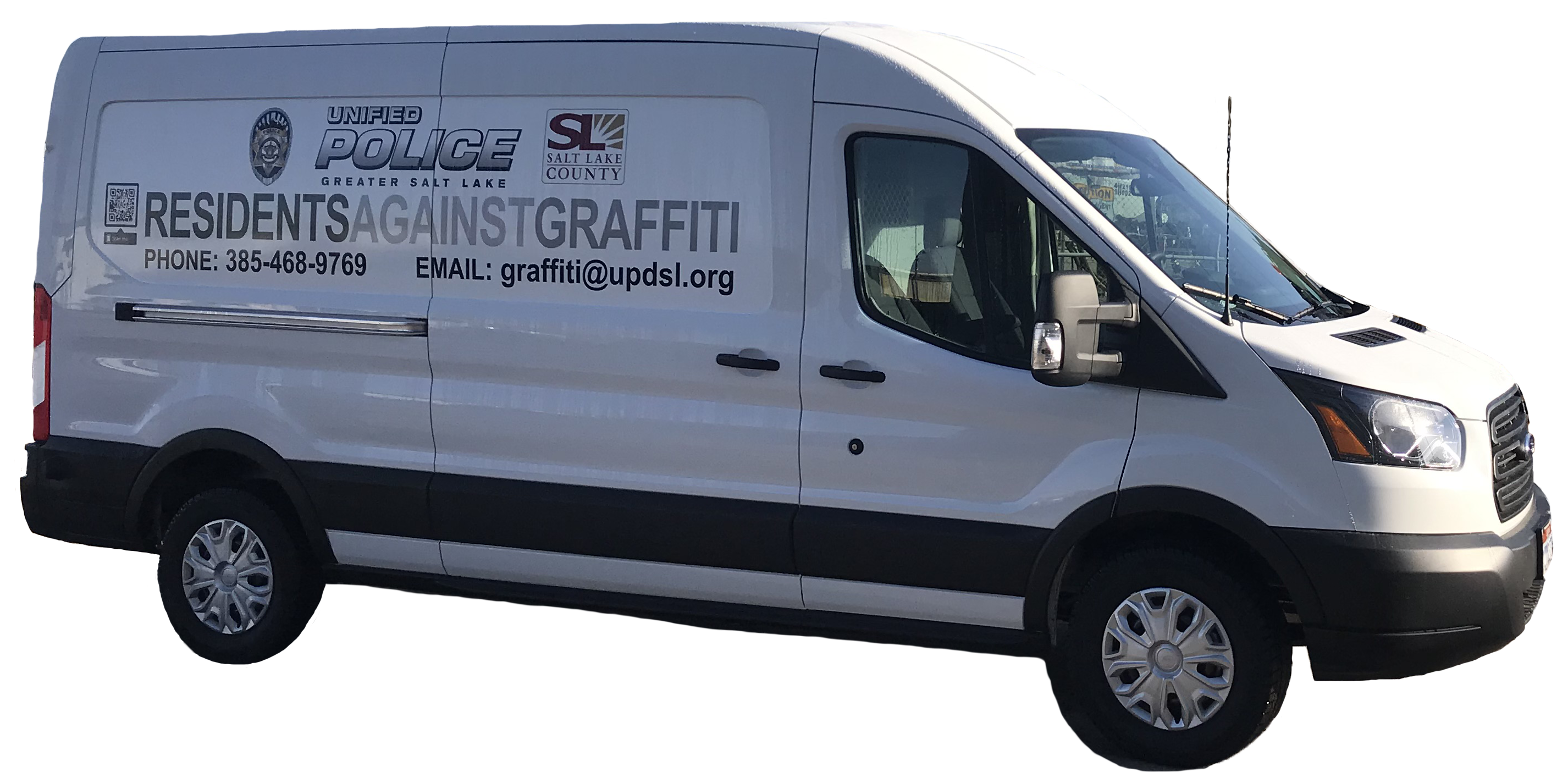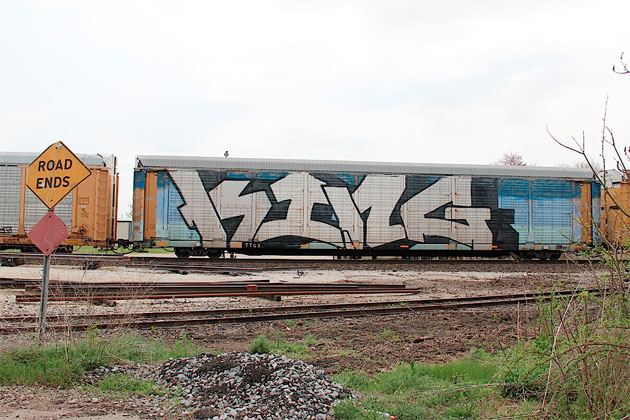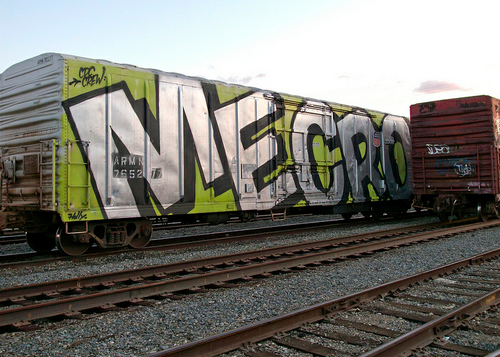
Residents Against Graffiti

Remember the three Rs
The UPD, Salt Lake County and the Salt Lake Area Gang Project provide several resources for cleaning and fighting graffiti. Keep in mind the 3 Rs: Report, Remove, Re-group.
Report
Report graffiti to the UPD via email (graffiti@updsl.org) or call 385.468.9769.
Remove
The UPD can provide you with free graffiti removal supplies and can even assign an officer for protection during removal. The UPD also employs graffiti removal specialists to remove graffiti on public property or private property with the permission of the property owner.
Re-group
Most graffiti perpetrators tire easily if graffiti is removed quickly (ideally within 24 hours). By organizing a neighborhood group, you can respond quickly to remove or report new graffiti and discourage further incidents. Read our tips for fighting graffiti and organizing a successful neighborhood group. You can also read the Salt Lake County Graffiti Ordinance. Click here for search details.
How to Report Graffiti
Call: 385.468.9769
Email: graffiti@updsl.org
Utah Department of Transportation
801.265.9267
Salt Lake City
801.972.7885
Email: graffiti@slc.ut.us
West Valley
801.963.3467
Sandy City
801.561.6712
To report graffiti online complete the following form:
Get Involved
Organize Your Neighborhood
Organizing a neighborhood group is one of the most effective ways to fight graffiti. Perpetrators quickly tire when they see that their efforts are removed and will go elsewhere.
Here are some tips for organizing a neighborhood group:
- Hold a neighborhood watch meeting and invite a UPD Officer to attend
- Divide the neighborhood into small areas and appoint area coordinators who are responsible for inspecting their areas for graffiti and mobilizing cleanup crews within 24 hours.
- Equip as many residents as possible with cleanup supplies, protective clothing and safety gear.
- Take safety precautions by cleaning graffiti in small groups, preferably with at least one adult in attendance.
- Be diligent. It might take 3 or 4 times before the vandal gives up and goes somewhere else.
RESIDENTS AGAINST GRAFFITI

The Unified Police Department partners with Salt Lake County to employ graffiti cleanup specialists and a program coordinator. The program provides clean up supplies to residents free of charge. The graffiti cleanup specialists will also assist residents with graffiti removal on their property free of charge. The specialists cleaned 7,930 sites in 2018. They take a proactive approach to graffiti cleanup and remove graffiti on public property when they see it. The program goal is to remove graffiti within 24 hours of the report. The specialists carry various paint colors and removal supplies with them in their vehicle.
The graffiti removal specialists are availabe across Salt Lake County on request and work with several of the cities public works or code enforcement agencies with graffiti removal. Residents who are unable or are afraid to remove graffiti on their property can contact RESIDENTS AGAINST GRAFFITI for help anytime to report the graffiti via email (graffiti@updsl.org) or phone 385.468.9769 to get assistance with the removal.
Removing graffiti quickly is crucial to preventing further vandalism. You will be required to sign a waiver giving our specialists permission to enter your property and remove graffiti. The specialists will help you free of charge. They can also provide removal supplies if you want to do the removal yourself.
- Do not remove graffiti that is not on your property without the property owners consent.
- Cover or remove any new graffiti as soon as possible.
- Graffiti will usually increase in warmer months.
- Be persistent! Continue to cover or remove continuing graffiti.
- Use common sense and be safe!
- Be aware of road hazards or other hazards in the area.
- Evaluate the project for the best possible solution. Don't paint an unpainted surface if a solvent is a better solution.
- Graffiti removal supplies are available from UPD Residents Against Graffiti or at any home improvement store. Home improvement stores can also help match a paint color.
Please call the UPD Graffiti number to inquire about graffiti removal supplies and how to get them or for help with your removal at 385.468.9769.
GRAFFITI: That Writing on the wall
 It has been called the "Newspaper of the Streets." What exactly do those cryptic, seemingly unintelligible scribbles mean? Graffiti can be divided into two types: graffiti done by taggers and graffiti done by street gangs. Even though taggers and street gangs both use graffiti as an illegal form of communication, their intent is different. Taggers see graffiti as an art form, a game, or a friendly contest. Street gangs use graffiti to mark areas they frequent and to issue threats to their enemies.
It has been called the "Newspaper of the Streets." What exactly do those cryptic, seemingly unintelligible scribbles mean? Graffiti can be divided into two types: graffiti done by taggers and graffiti done by street gangs. Even though taggers and street gangs both use graffiti as an illegal form of communication, their intent is different. Taggers see graffiti as an art form, a game, or a friendly contest. Street gangs use graffiti to mark areas they frequent and to issue threats to their enemies.
TAGGER GRAFFITI


Taggers are generally less violent than traditional street gangs. Tagger graffiti differs from street gang graffiti in that it is generally more intricate and more "artistic" than the graffiti from a street gang would be. The graffiti may be entwined and turned upside down or sideways to the point of looking more like a maze than letters.
The graffiti is usually done in several colors and might include caricatures of animals or humans. Taggers would call this type of graffiti a "piece," presumably short for "masterpiece." This kind of piece is usually designed ahead of time, and may have been sketched out in a notebook beforehand.
Underground magazines and newsletters publish tagger pieces. A worldwide network exists to keep taggers in touch with each other. Many taggers believe what they are doing is street art and is not a crime.
Another activity taggers are involved in is "tagging," putting their moniker or "tag," in as many places as they can. Taggers engage in contests with other groups, trying to outdo each other in terms of the number of "tags" put up, the difficulty of the artwork, or the difficulty of the location of the tag.
Taggers gain visible recognition from their graffiti. The more visible a wall, the more desirable it is to taggers. Freeway overpass signs, water towers, and billboards can quickly build a tagger's reputation. They call it "tagging the heavens."
Taggers will sometimes use sticky-backed labels (like the name tags that are often handed out at training seminars). The tagger will write his moniker on 10 to 20 labels and then as he walks through an area he'll just peel off the backing and put the label on any surface he passes. Some typical tagger monikers are "Nope," "Dime," "Bug," "Smok," "Toke," and "Rek."
PParents who believe that their child is involved in tagging should look for spray paint cans, a collection of aerosol spray tips, wide-tip markers, glass etching tools, surgical gloves, name tag stickers, and photographs or self-made videos of graffiti. Sketches of graffiti, practice sheets containing a moniker, or school notebooks with doodles that resemble graffiti may indicate tagging activity. Paint or marker dye on the hands or extra-large, hooded coats with large cargo-type pockets often indicate an involvement in tagging.
STREET GANG GRAFFITI
Street gang members use graffiti to increase their visibility, recruit new members, threaten rivals, and to intimidate residents in the area. Gang graffiti may show alliances between gangs, mark the scene of a crime, or commemorate the death of a beloved "homie" (with slogans such as "In memory of ......" or "RIP ......").
It usually includes the gang name and possibly a list of the monikers of several members in the gang or perhaps a threat aimed at a rival group (with slogans such as "187 ....." or "CK" or "BK"). Monikers that are typical in street gangs are "Smiley," "Flaco," "Scrappy," "Payaso," "Goofy," "P dog," or "T-Locc." Telephone area code prefixes are sometimes included, and, although Utah's "801" and "385" code is used, codes from California seem to be very popular and "213," "310," and "714" are often seen.
 Street gang graffiti may be done in old English-style letters, balloon (or block) letters, or simple, single-stroke letters. Many of the Hispanic gangs will include Spanish phrases such as "Loco" (Crazy), or "Rifa" ("We control") or "Rifamos" ("We are best"). Cross-outs of individual letters or of rival gang names are common. Individual letters are crossed-out when that letter is in a rival gang's name. For example, a Blood set may cross out all the Cs in any graffiti.
Street gang graffiti may be done in old English-style letters, balloon (or block) letters, or simple, single-stroke letters. Many of the Hispanic gangs will include Spanish phrases such as "Loco" (Crazy), or "Rifa" ("We control") or "Rifamos" ("We are best"). Cross-outs of individual letters or of rival gang names are common. Individual letters are crossed-out when that letter is in a rival gang's name. For example, a Blood set may cross out all the Cs in any graffiti.
Street gang graffiti may contain derogatory references toward rival gangs. Blood sets may refer to Crip sets as "Crabs" and Crip sets may use "Slobs" in their graffiti as an insult to Blood sets. Gang graffiti that includes "187" indicates a threat to kill. "187" is the California penal code for homicide, and, used in street graffiti, tells rival gangs that those who painted the graffiti intend to kill them.
The number "13" and "14" are often used in street graffiti, mostly among Hispanic gangs. The "13" may be represented as "XIII," "X3," "13," or with the word "trece." There are various explanations for the use of the number "13." The thirteenth letter of the alphabet is "M" and one explanation says that "M" refers to the Mexican Mafia; another says it stands for Mexico, the homeland; and another says that it refers to a street in Mexico that starts with the letter "M"--the street where the first gang was started. A "14" may be written as "XIII", "X4" or simply "14". The 14th letter of the alphabet is "N" and usually refers to the Nuestra Familia as a parent organization to Norteno gangs.
Other gang names often seen in gang graffiti are "D St" for Diamond Street, "TCG" for Tongan Crip Gangsters, "sXe" for Straight Edge, "G-13" for Gardenia 13, "QVO", "VLT" for Varrio Loco Town "Sur 13" or "Sur 38" for Surenos 13 or Surenos 38, and "21" for 21st Street. "WS" for Westside or "NS" for Northside are also common.
What Can I Do?
Get involved and get your neighborhood involved
ALWAYS paint over graffiti immediately or call an agency which will paint it free for you. Research done in California shows that areas that are immediately painted over are much less likely to be "hit" again. Graffiti that is left up becomes a status symbol.
NEVER confront or challenge someone who is actively tagging or putting up graffiti. Street gang members are very often armed and may assault a challenger even if they are not. Remember, even taggers may be armed. If possible, obtain an accurate description of the individuals, graffiti, vehicle, and license plate number. Video of graffiti activities are also useful. All information should be passed on to your local law enforcement agency to investigate. Be a good witness and report the information to your local police agency as soon as possible.
Removing Graffiti
Removal Tips
Removing graffiti quickly is crucial to preventing further incidents. The UPD can help you by providing graffiti removal supplies and can even assign an officer to be present during removal if there's any fear of danger. Here are some tips for effective graffiti removal:
- Before cleaning, always get the property owner's permission.
- Clean new graffiti within 24 hours of its discovery.
- Be prepared to increase your efforts during the warm months.
- Be persistent! Continue to remove or cover recurring graffiti until the vandals get tired and give up.
- If your personal safety is a concern, request a uniformed police officer in a marked vehicle to accompany your cleanup group.
- Use common sense. Minimize the chance of injuries by attempting to remove graffiti where it is easily accessible, and be aware of road hazards.
- Before cleaning evaluate the project. Make sure the paint matches the wall. Do not paint a surface that has never been painted or can be cleaned with a cleaning solvent.
Graffiti Removal Products
- ERASE aerosol spray - available from the UPD or at Zep Manufacturing 801.975.9831.
- Outdoor latex paint - available at hardware and paint stores. Try to match the original color.
- Brake and carburetor cleaner - available at most automotive stores.
- Power washing - using pressurized water and mild detergent.
- Sandblasting - Use as a last resort. May damage surface.
MGU
2024 Gang Conference
July 29th and 30th, 2024
Utah Cultural Celebration Center
1355 West 3100 South,
West Valley City, Utah

Choose Gang Free
Gang Prevention For Parents
For additional information or help getting your child out of a gang. choosegangfree.com
Contacts
- 385.468.9770
To report a crime or request to speak with a officer, call Dispatch at 801.840.4000. For all emergencies, call 9-1-1.
- 3365 South 900 West
Salt Lake City, Utah 84119
Gang Activity?
Send tips to:
GangTips@updsl.org
or call
385.468.9768
Tattoo Removal
Click here to learn about tatoo removal
Graffiti
Click here to learn about graffiti removal
